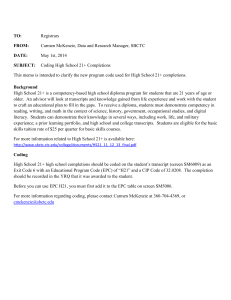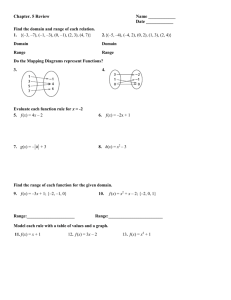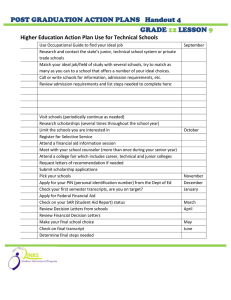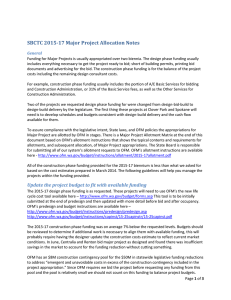STUDENT DATA Required Data Elements (Listed in alphabetical order)
advertisement
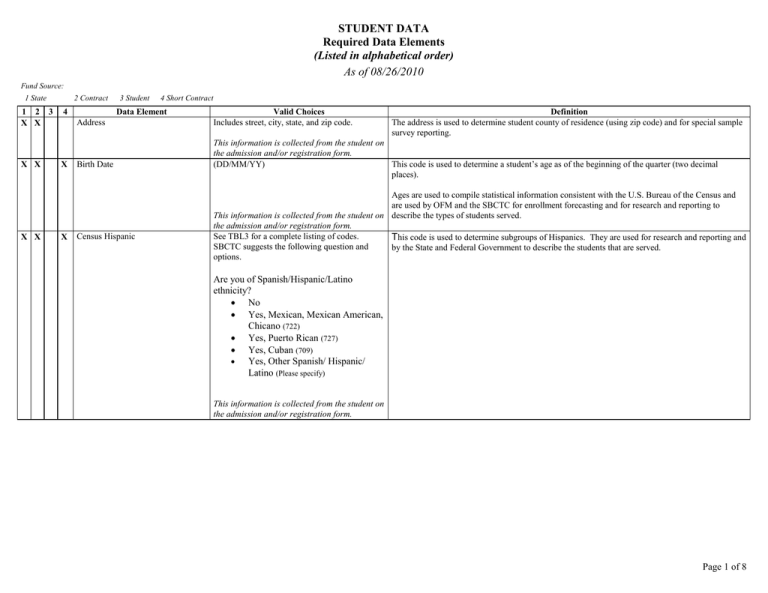
STUDENT DATA Required Data Elements (Listed in alphabetical order) As of 08/26/2010 Fund Source: 1 State 1 2 3 X X X X X X 2 Contract 4 3 Student Address X X 4 Short Contract Data Element Birth Date Census Hispanic Valid Choices Includes street, city, state, and zip code. Definition The address is used to determine student county of residence (using zip code) and for special sample survey reporting. This information is collected from the student on the admission and/or registration form. (DD/MM/YY) This code is used to determine a student’s age as of the beginning of the quarter (two decimal places). Ages are used to compile statistical information consistent with the U.S. Bureau of the Census and are used by OFM and the SBCTC for enrollment forecasting and for research and reporting to This information is collected from the student on describe the types of students served. the admission and/or registration form. See TBL3 for a complete listing of codes. This code is used to determine subgroups of Hispanics. They are used for research and reporting and SBCTC suggests the following question and by the State and Federal Government to describe the students that are served. options. Are you of Spanish/Hispanic/Latino ethnicity? No Yes, Mexican, Mexican American, Chicano (722) Yes, Puerto Rican (727) Yes, Cuban (709) Yes, Other Spanish/ Hispanic/ Latino (Please specify) This information is collected from the student on the admission and/or registration form. Page 1 of 8 1 2 3 4 X X X Data Element Census Race Valid Choices Definition See TBL3 for a complete listing of codes. This code is used to determine a student’s race/ethnic origin. They are used for research and SBCTC suggests the following codes at a reporting and by the State and Federal Government to describe the students that are served. minimum, you are not prohibited from including additional categories. White (800) African American (872) American Indian (597) Alaska Native (015) Native Hawaiian (653) Other Pacific Islander (681) Vietnamese (619) Filipino (608) Chinese (605) Korean (612) Japanese (611) Other Asian (621) Other Race (Please specify) X X Citizenship Status This information is collected from the student on the admission and/or registration form. See TBL3 for a complete listing of codes. Indicates whether a student is a US citizen, immigrant, refugee or living in the country on a visa. This information is collected from the student on the admission and/or registration form. X X Disability Y = Yes N = No This code indicates whether or not a student is disabled. It is used for monitoring service levels for people with disabilities and for reporting and research. Blank = No (default) This information is collected from the student on the registration form only. Page 2 of 8 1 2 3 X X 4 X Data Element Economically Disadvantaged Valid Choices Y = Yes N = No Blank = No Definition A code that indicates whether a student received need based financial aid in the year of enrollment. This data element is used for Carl Perkins reporting, reporting and research. Students receiving the following aid are automatically coded economically disadvantaged for the year in which they receive such aid when colleges run Job Number SR1211J. This data element is derived in the SMS system. 3% Need-based Waiver Pell Grants Supplemental Educational Opportunity Grant (SEOG) National Defense Student Loan (NDSL) Nursing or other Health Care Loan Nursing or other Health Care Scholarship Federal College Work Study Program (CWSP) Federal College Work Study Program (CWSP), Off-Campus State Need Grant (SNG) State Work Study, On-Campus State Work Study, Off-Campus Federal Vocational Work Study TW Needy/DADV Colleges may manually code students as economically disadvantaged if: (these students must be recoded each year) The student is not receiving aid but is reported as disadvantaged according to Carl Perkins regulations such as the Bureau of Indian Affairs students or the Economically Disadvantaged Workers Adjustment Assistance Act (EDWAA) students. Students who require special services and assistance in order to enable them to succeed in vocational programs and: Receive TANF payments or Benefit from food stamps or Counted for 1005 of Chapter I or Title I of the Elementary and Secondary Act of 1965 Are eligible for free or reduced lunch programs Whose family income meets low income guidelines Page 3 of 8 1 2 3 X X X 4 Data Element Educational Program Code (EPC) Family Status X Fee Pay Status (FPS) X X Gender Valid Choices See TBL 3 or the Course Coding and Crosswalk Manual for a complete listing of codes. This code is assigned by the college. 11 = Single parent with children/dependents 12 = Couple with children/dependents 13 = Without children/other dependents 90 = Other Blank = Not reported Definition Indicates a student’s planned field for a degree or certificate. All students with an intent code of F, G, H, I, K, J and M (see Student Intent for descriptions) must be assigned an educational program code. Except for New Chance or Basic Skills classes, colleges must also assign an EPC to Worker Retraining students which best matches their major or area of study. Educational Program Code is converted to program CIP during the MIS process. This data element is used for reporting and research when describing the students served. This information is collected from the student on the registration form only. For a complete listing of Fee Pay Status codes This code describes the types of fees a student is paying for each class. The fee pay status code may see TBL3. be assigned to a student or a class. This code is assigned by the college. M = Male F = Female Blank = Not Reported This data element is used for ad hoc research, tuition revenue projections, and OFM reporting. This code is used to describe a student’s gender. It is an important data element used to describe students in reporting and research. This information is collected from the student on the admission and/or registration form. Page 4 of 8 1 2 3 X X 4 Data Element Health Limitations 2 3 4 5 6 7 8 X X X X X High School High School Graduate Valid Choices Sub-Groups A Deaf B Severe to moderate Mobility hearing loss C Limited gait or range of Speech/ motion Language D Paraplegic E Quadriplegic Learning F Speech or language Disability disorder G Attention Deficit Blind Disorder H Dyslexia or Processing Chronic/Acute Deficit Health I Blind J Visual Disorder, other Neurological/ K Cancer Nervous L Cardiovascular, System Pulmonary M Orthopedic condition Psychological/ N Organ, blood, Emotional gastrointestinal, connective tissue, immune disorders O Motor-neuron P Acquired brain injury Q Developmental disability R Mental disorders S Autism spectrum disorders Category 1 Deaf/Hearing The college assigns this code. For a complete listing of High School codes see TBL3 in SMIS. Definition This code provides additional information for students coded with Disability = “Y”. It describes different types of health limitations for a student. Documentation of the disability is required to populate this field. This data element is used for reporting and research. The Category codes are required for SBCTC use. The Sub-Group codes are for campus use only. This is the student’s last high school attended. It is used for reporting data on the need for precollege course work, reporting to OFM, and for ad hoc research, especially related to Running Start students. This information is collected from the student on the admission and/or the registration form. Y = Yes This code indicates whether or not a student is a high school graduate. This code is used for N = No reporting back to high schools and research. Blank = No This information is collected from the student on the admission and/or the registration form. Page 5 of 8 1 2 3 X X X X X X 4 Data Element Intent Limited English Proficiency (LEP) Planned Length of Attendance Valid Choices A = General Studies, Degree or Certificate B = Academic Transfer D = High School Diploma/GED Certificate E = Developmental F = Vocational Preparatory (EPC Required) G = Vocational Preparatory Applicant (EPC Required) H = Vocational Apprentice (EPC Required) I = Applied Baccalaureate Program (EPC Required) J = Upgrading Job Skills (EPC Required) K = Non-Occupational Home and Family Life (EPC Required) L = General Studies M = Multiple Goal Seeker (EPC Required) X = Undecided Y = None of the Above This data element may be collected from the student on the registration form or entered by the college. Y = Yes N = No Blank = No (default) This data element is derived in the SMS system. 11 = One quarter 12 = Two quarters 13 = One year 14 = Up to two years, no degree planned 15 = Long enough to complete a degree 16 = I don’t know 90 = Other Blank = No response Definition Describes a student’s educational purpose, plans, intent or major for a specific year/quarter. The SBCTC uses student intent codes F, G, H, J, K and M to identify vocational students for Carl Perkins reporting, completions reporting, student tracking, and research. The Intent code is used along with the Student Purpose of Attending code to create the Kind of Student data element in the SBCTC Data Warehouse. Indicates whether a student was enrolled in a course designed to improve English speaking skills. Used for Carl Perkins reporting and for ad hoc research purposes. Students are automatically coded as having limited English proficiency as part of the Course Coding and Approval process. Colleges may manually code students as having limited English proficiency if: (These students must be re-coded each year) The student meets the Carl Perkins criteria of non-native speakers of English The student is a Native American with limited English skills who has sufficient difficulty speaking, reading, writing or understanding the English language so as to deny the student the opportunity to learn successfully or to participate fully in society. A student’s planned length of attendance at the time of registering. This code is used for reporting and research. This data element is collected from the student on the registration form only. Page 6 of 8 1 2 X X X X X X 3 4 X X Data Element Previous College Prior Education Purpose for Attending Resident Status Valid Choices See TBL3 for a complete listing of college codes. This data element is collected from the student on admission and/or registration form. 10 Less than 9th Grade 11 Less than high school graduation 12 GED 13 High school graduate 14 Some post high school, no degree or certificate 15 Certificate (less than 2 years) 16 Associate Degree 17 Bachelor’s Degree or above 90 Other This data element is collected from the student on the registration form only. 11 Take courses related to current or future work 12 Transfer to four-year college 13 High school diploma/GED 14 Explore career direction 15 Personal enrichment 90 Other This data element is collected from the student on the registration form only 1 = Resident 2 = Non-Resident 3 = Unknown Definition Indicates whether a student who enters the college reports credits from another higher education institution. This code is used for reporting and research to identify students who have previously attended college. This code indicates the student’s prior education. It is used to describe students in reporting and research. This code is the main descriptor of a student’s reason for attending college. It is used for student tracking, reporting and research. The Student Purpose of Attending code is used along with the Student Intent code to create the Kind of Student data element in the SBCTC Data Warehouse. This code indicates whether a student is a resident of Washington State. It is used for OFM reporting, tuition revenue projections, reporting and research. This data element is collected from the student on the admission and/or registration form. Page 7 of 8 1 2 3 X X 4 Data Element Work Status While Attending Valid Choices Definition 11= Full-time homemaker This code is used to determine a student’s work status and to identify WorkFirst and Worker 12= Full-time employment (incl. self- employed Retraining students. This data element is used for funding, research, reporting and OFM reporting. and military) 13= Part-time off-campus 14= Part-time on-campus 15= Not employed, but seeking employment 16= Not employed, not seeking employment 74= Unemployed TANF 75= Unemployed Low-Income Parent 76= TANF High Wage High Demand 77= Employed TANF 78= Employed Low-Income 79= Attending for Family Literacy as Final Goal 80 = Long-Tenured Dislocated Worker 81 = Short-Tenured Dislocated Worker 82 = Others receiving UI benefits 83 = Displaced Homemaker 84 = Was Self-Employed 85 = Boeing Displaced Workers 86= Vulnerable Worker 87= Disaster Impacted Workers 88= Displaced Veteran 90 = Other This data element may be collected from the student on the registration form or entered by the college. Page 8 of 8
